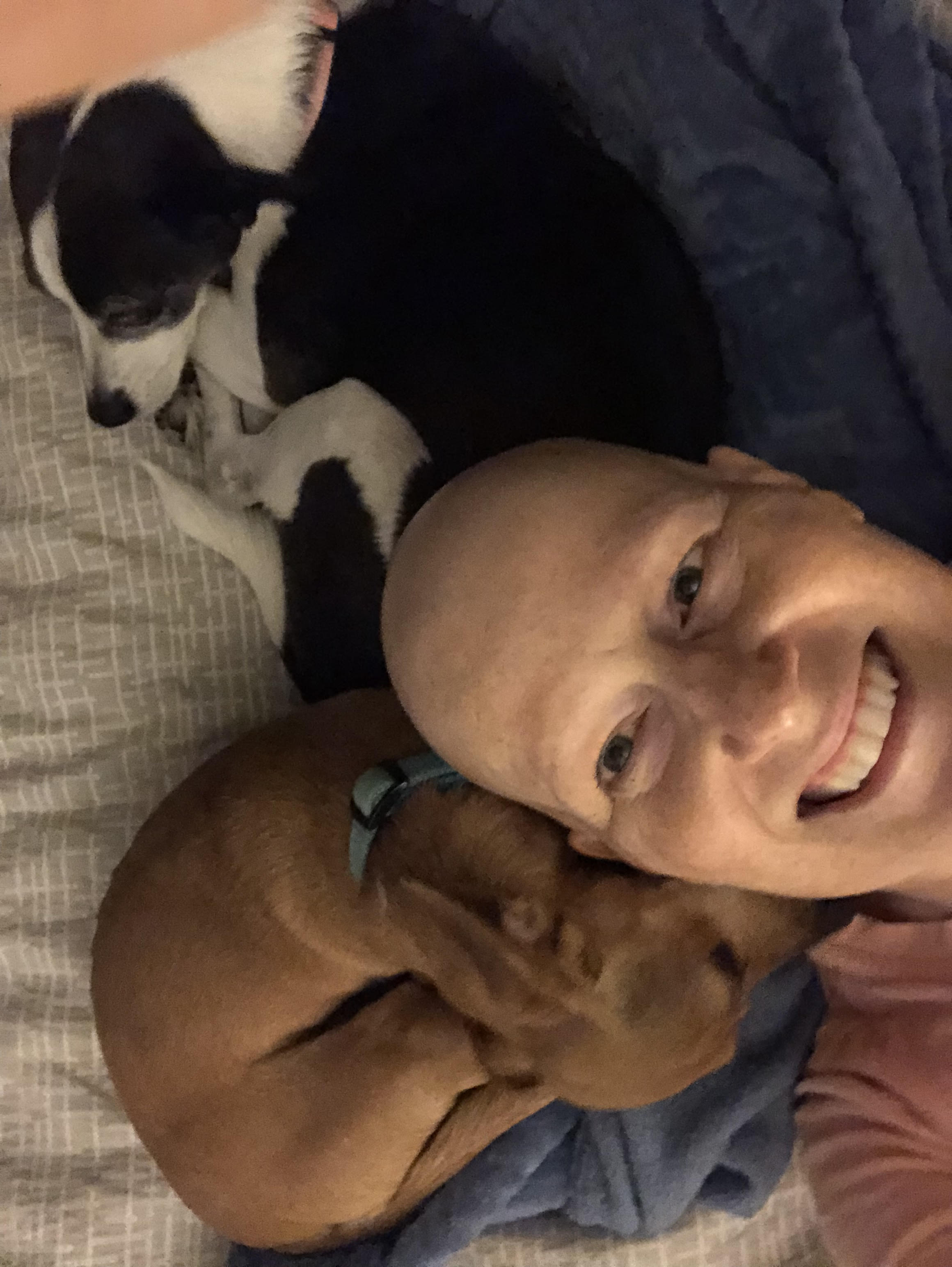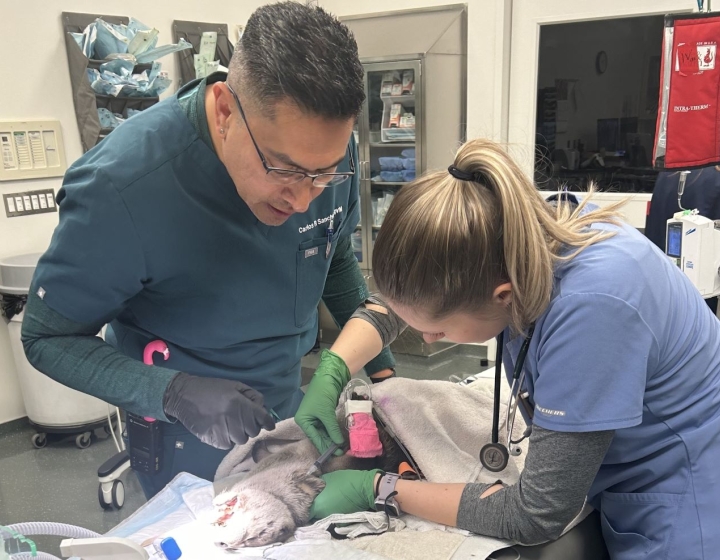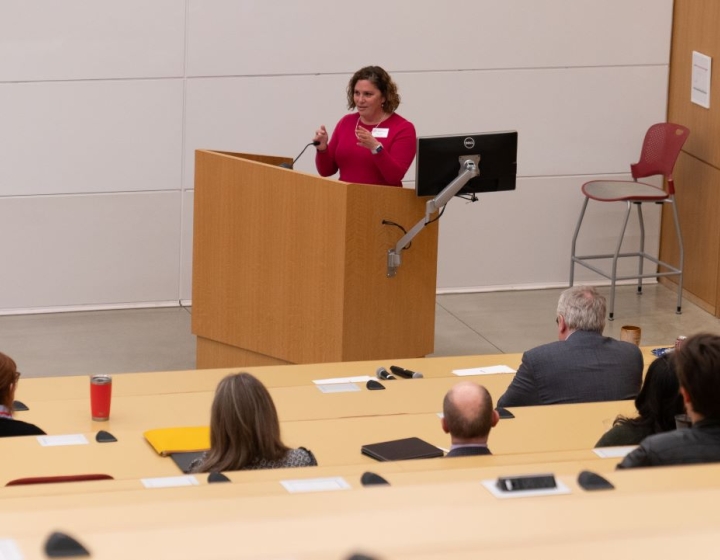Banking on a new understanding of canine and human lymphomas
It’s been one year since hair artist and salon owner Chelsey Pickthorn learned that, after beating an aggressive cancer called triple-negative breast cancer, it had metastasized and spread. After its return, she sought out a new oncologist who used precision medicine to determine the best course of treatment, by sequencing the tumor’s DNA. With targeted therapy and significant changes to her diet, the new tumors are shrinking dramatically — an amazing achievement against such an aggressive disease.
Now, Pickthorn’s dogs are joining her in the fight, by participating in research at Cornell to expand the potential of precision medicine for canine and human patients. Dr. Jan Krumsiek, assistant professor of Physiology and Biophysics at Weill Cornell is partnering with Dr. Marta Castelhano, director of the Cornell Veterinary Biobank, to study a type of lymphoma that occurs frequently in humans and dogs. They’re looking not at the tumor’s DNA, but at its metabolism. By analyzing blood samples from healthy dogs — like Pickthorn’s two beloved pups — and dogs diagnosed with lymphoma, the researchers will look for similar metabolic changes that also occur in human lymphoma cases. These similarities can help establish dogs as a model for studying human cancers, which the researchers hope will lead to better testing and treatment options for both species.
“In the long run, we hope to use this research beneficially for both dogs and humans,” says Krumsiek. “If you learn something about human cancer, maybe we can also apply it to our canine companions, and help them live longer, healthier lives.”
Learning lessons from Man’s best friend
Dogs and humans suffer from similar types of cancer, but effective treatments for canine cancer have lagged behind human therapies. By placing dogs front and center in cancer research, scientists may be able to expand treatment options for our furry friends.
Furthermore, dogs are an excellent species for studying cancer. They share the same environment as humans and develop cancers spontaneously. Their cancers also develop sooner, due to their shorter lifespan, which accelerates the research. “The missing piece for learning about a specific disease could be sitting on your couch, or sleeping in your bed, and we are not really taking advantage of the power of this model,” says Castelhano.
The new collaboration began in the fall of 2019, during a coffee break at a conference at Weill Cornell’s Englander Institute for Precision Medicine, where Krumsiek is a member. Krumsiek studies metabolic changes in the body for diseases like Alzheimer’s, cancer and diabetes using a technique called metabolomics. The technique involves identifying and measuring the levels of thousands of metabolites that result from chemical processes in cells and organs, and analyzing how the levels change in response to disease. Castelhano was eager to learn how Cornell’s Biobank could contribute to this new area of research, and impact the lives of precision medicine patients.
With 14 years of experience in biobanking, Castelhano uses high-quality samples from veterinary patients to translate clinical findings into research innovations. Those samples are carefully curated by Castelhano and her team at the Biobank — the first in the world to receive accreditation to an international standard for biobanks. Castelhano’s banked blood samples from sick and healthy canines provided the perfect opportunity to study the metabolomics of diseases shared by humans and dogs.
Castelhano and Krumsiek first chose to focus on diffuse large B-cell lymphoma (DLBCL), to advance research established by Dr. Kristy Richards, ’90, an oncologist at Weill Cornell and the College of Veterinary Medicine, who was a colleague and friend of Castelhano. She was a pioneer in translational research, comparing canine and human lymphoma to find new diagnostics and treatments, until her death from triple-negative breast cancer in 2019.
DLBCL is the most common type of non-Hodgkin’s lymphoma and creates similar symptoms in humans and dogs. Using metabolomic data from healthy dogs and ones with DLBCL, Krumsiek is looking for metabolic changes caused by the cancer that show up in the blood. If these same changes occur in people with DLBCL, then dogs could be an effective model for studying the human form of the cancer, and for identifying targets for new drugs for both species.
Unleashing the power of banked samples
Krumsiek gave a seminar on this work, entitled "Metabolomics: From Pathogenesis to Precision Medicine,” at the College of Veterinary Medicine on February 14. Pickthorn and her two dogs, Hudson and Noma, attended the talk. They also visited the Cornell University Hospital for Animals, where the Biobank clinical team collected a blood sample, which was labeled, entered into the Biobank’s database, processed and carefully stored in a freezer. “Hudson and Noma were treated so nicely and felt really comfortable,” Pickthorn says. “It was really cool to be a part of it.” Pickthorn has also offered to donate her own blood to the human biobank at Weill. She became involved with the project when Castelhano discovered that she was a survivor of triple-negative breast cancer, and visited her salon.

Another cancer survivor, Lori Hill, also attended Krumsiek’s seminar and plans to donate her own blood, and samples from her two dogs, Tina and Nora. Hill, a physician assistant and dog-lover in the Ithaca area, was eager to help human and dog cancer patients in any way possible.
In 2017, Hill was diagnosed with follicular lymphoma, which is usually a slow-growing cancer related to DLBCL. Within six months, however, Hill developed a large tumor, which required a mix of chemo- and immunotherapy treatments. Now, 18 months later, she is in remission, but undergoes frequent follow-up testing. “Follicular lymphoma is always there and it can keep coming back,” says Hill. “If it comes back aggressive, it gets a little more scary, which is why the research that they’re doing is so tremendously important. They might be able to predict who it would happen to, and understand how to treat it. To me, this work is up close and personal, and I’m inspired by the potential.”
The future of precision medicine
If this project is successful, it may one day allow oncologists to use a patient’s metabolic profile — as well the DNA of the tumor — to design a precision medicine treatment plan. Genetic data shows what mutations a tumor has, but metabolomics reveal what is actually happening inside the cells.
While the researchers are starting with lymphoma, a metabolomics approach could be applied to any cancer or disease samples in the Biobank. “Biobanks are the core of precision medicine,” says Castelhano. “Every contribution to a biobank could improve your own health and advance precision medicine research, which may impact the lives of many other patients.”
Pickthorn was especially grateful for the precision medicine she received to treat her metastatic cancer. The mutations it uncovered qualified her for a clinical trial using an FDA-approved drug, which has yielded incredibly promising results. She also credits a healthier lifestyle and a diet of
whole and plant-based foods. Her success has made her particularly interested in how tumors impact the body’s metabolism, and how they respond to changes in diet.
“I made a commitment almost exactly a year ago, shortly after my diagnosis, that I was going to be in the one percent that lived past five years or 10 years or 15 years,” Pickthorn says. “I'm very optimistic.”
-By Patricia Waldron





